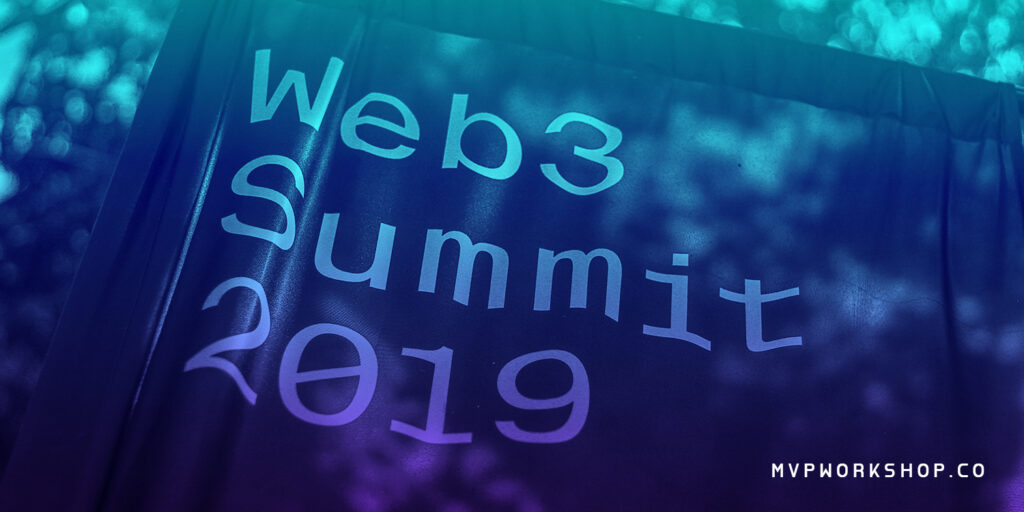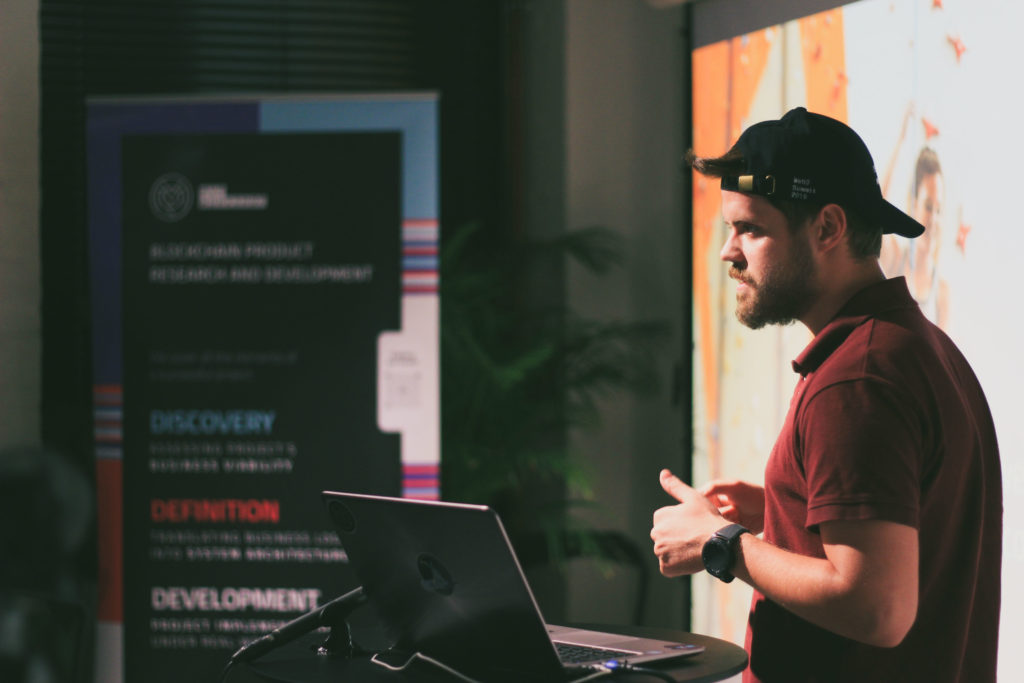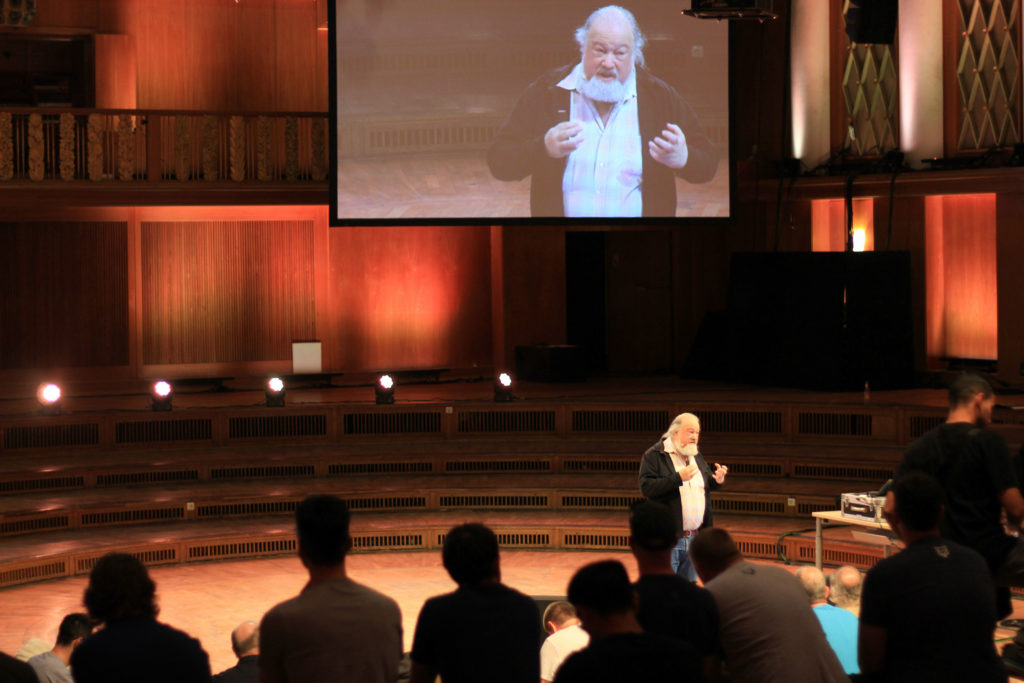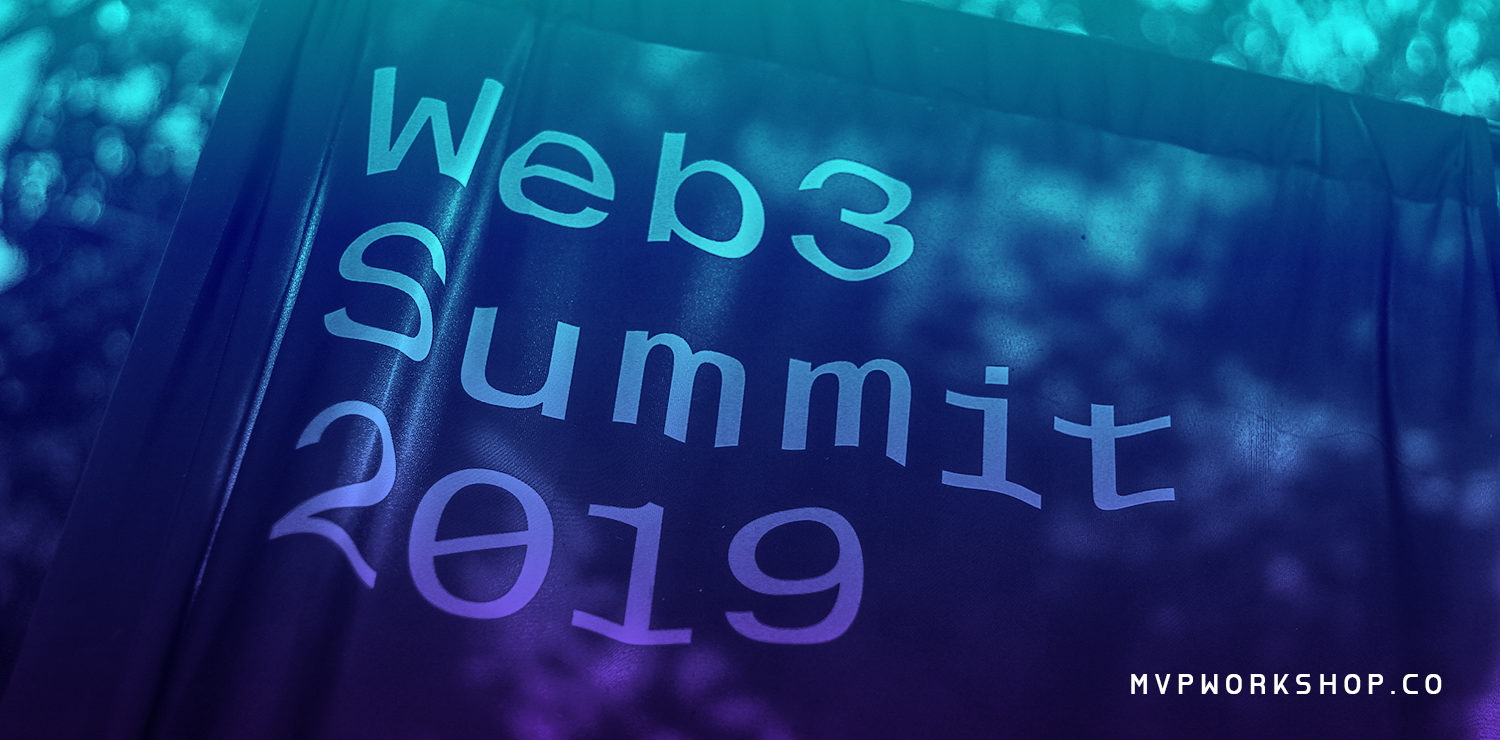TL;DR – we attended Berlin Blockchain Week which included Web3 Summit, DappCon, and our own community event organized at Parity offices. To sum up the highlights – we got some reality checks regarding privacy from Richard Stallman and Edward Snowden during Web3 Summit and saw first-hand the hype surrounding the DAOs.
Some interesting thoughts were shared on DappCon during a panel with Vitalik Buterin and Joseph Lubin, besides talks about decentralization without the blockchain hype and the team from Ethereum foundation dressing up in animal costumes for their presentation. So, let’s get into it.
Notable Mention
The most impressive talk we attended from the perspective of usability is definitely the Matrix project – a secure, decentralised, real-time communications platform. Besides being technically engaging it also showcased how something born out of Web3 is applicable and used by hundreds of thousands of people, including all branches of French government. You can check out their talk here.

DAOs
The people behind DAO projects such as Aragon, MakerDAO, Moloch and others had held numerous talks showcasing their solutions that enable fairer governance methods. The technology facilitating DAOs is young, and the ideas that humankind has been addressing for more than two millennia, from Plato’s “Republic” to Moloch’s “Rage Quits” and Aragon’s decentralized organization templates, still have a long way to go to facilitate complete fairness.
As Dr. Gavin Wood put it as his answer to the question of “How could AI and Blockchain technologies go together… if we use AI to make machines more intelligent, and blockchain to be governed by machines, in the end we will be governed by intelligent machines” – a dystopian outcome only if we fail to establish the proper principles and mechanisms that we need to feed to the machines.
The DAOs in that sense gave us a notion that most of the tech stuff is figured out, it is just that we need to further iterate on our ideas of an ideal governance for a specific organization type, a very challenging task but being tackled by some very smart people.

Online Reputation
SourceCred’s reputation protocol for online collaboration was briefly showcased. Imagine if the Social Credit system – such as the one in China – was used for facilitating fair governance and reputation building for individuals and blockchain projects, by using an approach logically similar to Google Page Ranking to create reputation sheets for all entities based on their characteristics and (inter)actions.
The Keynote Panel
Vitalik Buterin, Joseph Lubin, Stephen D. Palley and Ryan Selkis – we recommend watching the whole panel – they started talking about how to measure success from the perspective of blockchain adoption in general, but the discussion covers other relevant topics as well.
Decentralized storage
Decentralized storage was probably our main focus when choosing which workshops and talks to attend on DappCon and Web3 Summit. It is a challenge that we almost always face when creating the system architecture plan for a new product/client – where and how to store data most cost-efficiently so that it is tamper-proof, distributed and easily readable?
There is no single answer to that question, as the business requirements and focus differ from project to project. The first and easiest part is choosing between IPFS, dat://protocol, and networks such as FileCoin and Arweave for storing the data, as you would choose an underlying filesystem that best suits your database and redundancy needs in a centralized architecture.
The second part which is much trickier is choosing the right database and organizing the schema in an optimal way. OrbitDB & Textile for IPFS, and KappaDB for dat://. What all of these technologies share is something defined as Kappa Architecture, a subset of the Lambda Architecture, the pillar of Big Data processing, that had found a new home as a way to organize, structure and make data searchable on distributed data layers. Just having a general system in mind for structuring data on decentralized p2p data stores, such as Kappa Architecture, would greatly impact and ease the way we develop applications that rely on IPFS and similar technologies.

Polkadot & Substrate
With previous experience in working with Cosmos and Cosmos SDK, we were thrilled to take a look at the way Substrate can be employed to create parachains (interoperable parallel blockchains) and what advantages it has over Cosmos. Although it is not yet production ready, the critical difference that might be the killer feature for us is the Substrate’s WASM compilation – that thing alone spurs the imagination of what can be done to further ease the onboarding of new users onto dApps.
User Onboarding
OpenZeppelin is working on overcoming the user onboarding barriers on Ethereum. They announced the Gas Station Network which allows you as an app developer to pay for your users’ transactions, so they don’t need to set up an account and acquire ETH to pay for their gas. We call them meta-transactions.
GSN consists of four main parts:
RelayHub – keeping track of relayers, handling relayed transactions and charging their recipients.
Relayers – paying for the user’s transaction and gas by staking funds in the RelayHub. They charge the recipient contract plus a bit extra as a fee for their services.
Recipients – dApp contracts that pay for their users’ transactions. They need to import openZeppelin interfaces to accept the meta transactions.
Users – signing a transaction with any key, and sending it off-chain to a Relayer.
GSN is live on mainnet and you can also try it on testnet (Ropsten, Kovan, and Goerli). Beside the contracts library they also published a JavaScript library for easily managing your Web3 connections.
DEXs
Even if the vast majority of crypto trading volume is happening on centralized exchanges, there are still great projects that are trying to improve the DEX user experience:
– 0x announced mesh as a peer-to-peer network for relayers so they can share orders with one another and receive orders from the market maker. It also makes the integration of a new relayer with others much easier.
– Kyber Network also did a great job providing one endpoint for takers to perform multiple token swaps in one blockchain transaction. They maintain an asset reserve instead of order book like 0x.
– 3Box helps front-end web developers build dApps without needing to run a backend for handling user data. They use IPFS for decentralized storage, OrbitDB for database structuring, and 3ID for decentralized identity. Data is stored privately on 3Box so it is unreadable by other applications. Their JavaScript SDKs enable applications to run 3Box directly in the user’s browser or wallet so they don’t need to install any extra software to use the system. API is divided into three parts – profiles, storage and messaging. Each one has its own set of GET and SET methods.

Ethereum
It was comforting to summarize the Ethereum related talks and workshops and to come to a conclusion that the majority of ongoing efforts and talking points in the Ethereum dev community are oriented around making dApps more usable by an average tech consumer.
The timeline of the efforts can be mapped out with the following EIPs:
– EIP-725 Proxy contracts
– EIP-1077 Desktop mining
– EIP-1078 Logging in using ENS names
– EIP-1776 Native Meta Transactions
To sum things up, we now have a standardized way of onboarding new etherless users with SDKs such as Universal Login SDK. We are also closer to leaving bad security practices behind us by using Desktop Mining (Relaying) and Identity Proxy Contracts to onboard users who do not need to know how important it is to keep their backup phrases and private keys safe, but do know what a popup modal saying “Please scan the QR code and authorize the login for MyCoolDapp” means.
There are a lot more EIPs that influenced the outcome(s) we are seeing now with the Universal Login, and there are projects which influenced the EIPs themselves, such as status.im and uPort which have implemented these methods before they were standardized. If we failed to mention an effort which was vital to the better UX we are seeing with dApps nowadays, know that it was an unintentional error and please ping us so we can update this article and give proper attribution.
If you’re interested in exploring this topic more:
– Great talk by Alex Van Sande explaining better UX from using the above mentioned mechanism – Universal Logins for Ethereum – Alex Van de Sande – UX Unconf Toronto 2018
– Hands-on screencast by Austin Griffith demonstrating how meta transactions work – Meta transactions on Ethereum via Identity Proxy Contract
dApp Dev Tools
Although a bit behind the UX and the ease of user onboarding, the ecosystem surrounding developer comfort in the blockchain space is emerging. We have had the chance to chat with Zak Cole, CEO of whiteblock.io. They built a platform for spinning up private blockchain networks (currently EOS, ETH & Rchain), running tests on the network, gathering metrics on the nodes, and switching between different client implementations.
Our friends over at Tenderly, who themselves are building an amazing product which serves as a monitoring, alerting and troubleshooting tool for Ethereum Smart Contracts have won a prize at the EthBerlinZwei blockchain hackathon by implementing an EVM inside an identity contract making it possible to execute smart contracts without deploying them, effectively making the first blockchain REPL – sol.tty.

Freedom & Privacy
Two very important non-technical talks were given at the Web3 Summit which left a lasting impression – a (much needed) reality check if you will. Richard Stallman got on the stage to talk about the same things he had been talking about for years. Arguably the greatest advocate of individual and collective freedom in technology said nothing new, and the talk hadn’t mentioned anything related to Web 3.0. He focused on giving all of us present a reality check regarding the state of free software – a natural conclusion in our minds was how exacerbated what he is saying could be in blockchain in the future.
But, this is not a bad thing, since the agnosticity of his messages is something we really need right now, especially in blockchain. The thoughts and ideals that we all like to think we strive for, yet fall far from because of the compromises we make sacrificing freedom and embracing practicality rang in our ears with much more meaning this time. Stallman was addressing the public on an event made around a technology that just might rid us of the lazy compromises and trade-offs with our freedom and privacy.
Web 3.0 is the fertile ground for growing free software and nurturing the privacy and freedom that was slipping bit by bit from us on the Web 2.0 for decades. Following Stallman, the audience was addressed by the man who became a synonym for freedom, courage and persistence – we were greeted by none other than Edward Snowden – naturally, via video uplink. Snowden had shown his awareness of the importance of the Web 3.0 movement and how it might prevent eavesdropping, private data collection and unwilling monetization of our digital personas.
Snowden’s observation that if only we, the builders, keep our minds attuned to the core values of privacy and freedom every step of the way towards a mass adopted decentralized web, can we fulfill our responsibility and use the opportunity to give people back their freedom.
Onto the business side of things
What possibly stood out most and left the strongest impression with us during the whole week was the (almost) complete absence of any kind of business development talks. We’re mentioning this because we deem it extremely important for facilitating mass adoption of blockchain-based products and services on a global scale.
Notice that we said “blockchain-based” and not just “blockchain”. That’s because solutions are just that – solutions – regardless of the technological stack used for their implementation, but a wide-spread opinion persists in the global community that blockchain itself is the solution, which is not only inaccurate, it’s counterproductive for the goals we all want to achieve with the technology that is still very young. Business development, meaning business plans, revenue modelling, value streams, stakeholder analysis, user personas and flows, marketing strategies, and a hundred other elements are what is currently missing in the blockchain space – and that was more or less “fine”.
But as of now we need to put some focus on those areas pronto because these aspects of product development are what is going to help carry the blockchain space from a niche market which it is now to the mainstream adoption and true competition with traditional (centralized) products and services.
The situation we are finding ourselves in is completely natural – any new and disruptive technology adoption is driven by engineers in the beginning. The thing is, if we’re talking about blockchain actually becoming a part of everyday life for a random person on the street (and not for mostly enthusiasts as it stands right now), we need to bring awareness to blockchain space that development teams shouldn’t be just/mostly engineers.
At the end of the day, the user doesn’t really care (read: doesn’t care at all) if the underlying technology is blockchain or not – they only care about the end result, is the product/service solving their problem or pain point better than what they are using right now in a centralized space. This leads us to the conclusion that we need to approach the development of blockchain products and services as we do with any other, covering the complete vertical of necessary activities, and not (falsely) believe that just because something is on blockchain it will resonate it’s value with users as it does with engineers who actually architected it.
Develop your product or service without taking into account the technology for implementation – this will lead you to offer real value to all stakeholders in your system. Only then should you start shifting your focus towards choosing the best tool for the job, meaning deciding on a technological stack and it’s concrete implementation.
All of the above and much more is why we decided to pivot our event agenda midweek and focus more on the business development side of blockchain in our two talks and an AMA with Rick Dudley. The blog post is coming soon.



